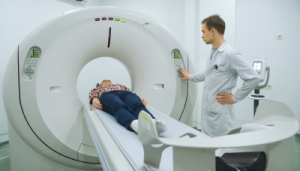
Whole-body MRI could yield an earlier diagnosis of SpA in patients with early inflammatory joint symptoms.
Alexandr Medvedkov / Shutterstock.com
MADRID—Researchers say that whole-body MRI could yield an earlier diagnosis of spondyloarthropathy (SpA) in patients with early inflammatory joint symptoms, according to findings presented in a poster session at the Annual European Congress of Rheumatology (EULAR). The approach could lead to earlier treatment and better outcomes, they say.
Investigators at the University of Leeds recruited 39 patients, an average of 43 years old, with early inflammatory joint symptoms, signs of inflammatory arthritis or both.1
An array of clinical data was collected, and patients were categorized clinically: 14 were deemed to have definite inflammatory arthritis in the form of either rheumatoid arthritis (RA) or SpA, and 25 had undifferentiated arthritis (UA).
They underwent 3.0 Tesla, T2-weighted fat-suppressed MRI of the spine and sacroiliac joints before IV contrast, and 3D VIBE Dixon imaging of the peripheral joints and enthuses postcontrast.
Patients in the CCP-positive RA group were found to have disease activity mainly in the small joints and tendons. Those in the CCP-negative group had disease activity that was large-joint based, with half having sacroiliac joint disease.
In the undifferentiated group, patients with persistent UA had disease distributed in both the axial and peripheral areas, involving both the joints and the enthuses, with a quarter having sacroiliac joint disease. Among those with resolved UA, there was a similar distribution of disease, but with no sacroiliac disease.
A year after the imaging, six more patients were diagnosed with SpA—three patients in the CCP-negative RA group and three in the persistent UA group, all of whom had baseline MRI findings that were similar to the patients already diagnosed with SpA at baseline.
Using whole-body MRI could make a difference for patients, especially those in the antibody-negative group, said Jane Freeston, MD, a consultant rheumatologist at the University of Leeds.
“The options for the group that don’t quite fit nicely into normal patterns [can be limited],” she said. “They do badly because no one can really work out what’s going on. And this offers a better way to understand what’s wrong with them and then treat them earlier and more appropriately.”
About 40% of patients with psoriasis end up being diagnosed with psoriatic arthritis, & early treatment leads to better outcomes.
Ultrasound Reveals Active Inflammation
In another study, researchers found that RA patients in long-standing clinical remission after being treated with a DAS28 treat-to-target approach still had signs of active inflammation on ultrasound, whether they’d been treated with conventional synthetic disease-modifying anti-rheumatic drugs (csDMARDS) or biological DMARDS.2
